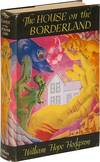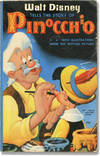
On the Rotational Coefficient in nickel and cobalt (Hall, pp. 157-172) WITH On Logical Diagrams for N Terms (Marquand, pp. 266-270) in The London, Edinburgh, and Dublin Philosophical Magazine and Journal of Science 12, 1881
by Hall, E. H. [Edwin] WITH Alan Marquand
- Used
- Hardcover
- first
- Condition
- See description
- Seller
-
West Branch, Iowa, United States
Payment Methods Accepted
About This Item
London: Taylor and Francis, 1881. 1st Edition. Bound, full volume first edition of two papers: EDWIN HALL'S SIGNIFICANT FOLLOW-UP WORK TO HIS 1880 DISCOVERY OF THE HALL EFFECT, a "seminal and foundational experiment of condensed matter physics" (Armitage, Notes on Hall Effect Experiments). The paper offered presents further work on the Hall Effect. Withbound, ALAN MARQUAND'S FIRST MECHANICAL LOGICAL ENGINE, "one that is still extant" (Wikipedia). Both papers are discussed below.
HALL'S PAPER: "The Hall effect occurs when an electric current is placed in a magnetic field, causing a potential difference and a transverse field is created. By measuring the potential one can calculate the strength of the magnetic field" (Armitage). "The Hall Effect... provides an introduction to computer acquisition, magnetic probes, and transport experiments... which are really the bread and butter of condensed matter experiments. It is only a slight overstatement to say that all other experiments one does in condensed matter are simply higher order experiments to shed light on interesting phenomena observed in transport" (ibid).
After publication of his famous 1880 paper (which we offer separately both as a bound extract and as a full volume), Hall travelled to Europe to make further measurements with respect to his discovery, this time using Helmholtz's Berlin laboratory. He first presented the results of that work as a paper and speech delivered to the British Association; the paper offered here, printed in the same year, is both an extension of the 1880 work and an extended version of the 1880 British Association work. The paper was very well received.
Writing in the Biographical Memoirs of the National Academy of Sciences, Bridgman quoted Lord Kelvin's comments about Hall's 1881 work: "‘The subject of the communication [and paper] is by far the greatest discovery that has been made in respect to the electrical properties of metals since the times of Faraday-a discovery comparable with the greatest made by Faraday'" (Biog. Mem. Nat. Acad. Sci. 21 73-94).
MARQUAND PAPER: While studying at Princeton, Marquand was inspired by the related work of William S. Jevons to build a mechanical logical machine. Marquand presented his machine in the paper offered here and it is considered "an improved version of the Jevons machine. The Marquand Logic Machine was smaller, the number of keys reduced, and its system of rods, springs, and levers proved far more sophisticated than previous mechanisms. The control panel of the instrument resembled Marquand's logic diagram of overlapping rectangles.
"Although it performed the same operations as the Jevons-type machine, Marquand felt that his device could be easily adapted to solve much larger problems. Both Jevons and Marquand had used De Morgan's negative terms (represented by lowercase letters) as inputs to their machines. One interesting aspect of Marquand's machine is that entire premises of the syllogism had to be input in the negative. His machine then eliminated any conclusions that agreed with the negative of the premises, as those would contradict the premises" (Bennett, Logic, 163). CONDITION & DETAILS: London: Taylor and Francis. Complete. Volume inclusive of 11 plates. 4to (8.75 x 5.75 inches; 219 x 144mm). Small red Japanese stamp on title page. Handsomely and solidly bound in three quarter brown calf over marbled paper boards. Five gilt-ruled raised bands at the spine; gilt armorial devices in the compartments. Gilt-lettered red and black morocco spine labels. Moderate toning throughout, most noticeably to the endpapers. The majority of the text is clean and bright. Very good.
HALL'S PAPER: "The Hall effect occurs when an electric current is placed in a magnetic field, causing a potential difference and a transverse field is created. By measuring the potential one can calculate the strength of the magnetic field" (Armitage). "The Hall Effect... provides an introduction to computer acquisition, magnetic probes, and transport experiments... which are really the bread and butter of condensed matter experiments. It is only a slight overstatement to say that all other experiments one does in condensed matter are simply higher order experiments to shed light on interesting phenomena observed in transport" (ibid).
After publication of his famous 1880 paper (which we offer separately both as a bound extract and as a full volume), Hall travelled to Europe to make further measurements with respect to his discovery, this time using Helmholtz's Berlin laboratory. He first presented the results of that work as a paper and speech delivered to the British Association; the paper offered here, printed in the same year, is both an extension of the 1880 work and an extended version of the 1880 British Association work. The paper was very well received.
Writing in the Biographical Memoirs of the National Academy of Sciences, Bridgman quoted Lord Kelvin's comments about Hall's 1881 work: "‘The subject of the communication [and paper] is by far the greatest discovery that has been made in respect to the electrical properties of metals since the times of Faraday-a discovery comparable with the greatest made by Faraday'" (Biog. Mem. Nat. Acad. Sci. 21 73-94).
MARQUAND PAPER: While studying at Princeton, Marquand was inspired by the related work of William S. Jevons to build a mechanical logical machine. Marquand presented his machine in the paper offered here and it is considered "an improved version of the Jevons machine. The Marquand Logic Machine was smaller, the number of keys reduced, and its system of rods, springs, and levers proved far more sophisticated than previous mechanisms. The control panel of the instrument resembled Marquand's logic diagram of overlapping rectangles.
"Although it performed the same operations as the Jevons-type machine, Marquand felt that his device could be easily adapted to solve much larger problems. Both Jevons and Marquand had used De Morgan's negative terms (represented by lowercase letters) as inputs to their machines. One interesting aspect of Marquand's machine is that entire premises of the syllogism had to be input in the negative. His machine then eliminated any conclusions that agreed with the negative of the premises, as those would contradict the premises" (Bennett, Logic, 163). CONDITION & DETAILS: London: Taylor and Francis. Complete. Volume inclusive of 11 plates. 4to (8.75 x 5.75 inches; 219 x 144mm). Small red Japanese stamp on title page. Handsomely and solidly bound in three quarter brown calf over marbled paper boards. Five gilt-ruled raised bands at the spine; gilt armorial devices in the compartments. Gilt-lettered red and black morocco spine labels. Moderate toning throughout, most noticeably to the endpapers. The majority of the text is clean and bright. Very good.
Reviews
(Log in or Create an Account first!)
Details
- Bookseller
- Atticus Rare Books
(US)
- Bookseller's Inventory #
- 1175
- Title
- On the Rotational Coefficient in nickel and cobalt (Hall, pp. 157-172) WITH On Logical Diagrams for N Terms (Marquand, pp. 266-270) in The London, Edinburgh, and Dublin Philosophical Magazine and Journal of Science 12, 1881
- Author
- Hall, E. H. [Edwin] WITH Alan Marquand
- Book Condition
- Used
- Quantity Available
- 1
- Edition
- 1st Edition
- Binding
- Hardcover
- Publisher
- Taylor and Francis
- Place of Publication
- London
- Date Published
- 1881
Terms of Sale
Atticus Rare Books
30 day return guarantee, with full refund including shipping costs for up to 30 days after delivery if an item arrives misdescribed or damaged.
About the Seller
Atticus Rare Books
Biblio member since 2010
West Branch, Iowa
About Atticus Rare Books
We specialize in rare and unusual antiquarian books in the sciences and the history of science. Additionally, we specialize in 20th century physics, mathematics, and astronomy.
Glossary
Some terminology that may be used in this description includes:
- Title Page
- A page at the front of a book which may contain the title of the book, any subtitles, the authors, contributors, editors, the...
- Device
- Especially for older books, a printer's device refers to an identifying mark, also sometimes called a printer's mark, on the...
- Morocco
- Morocco is a style of leather book binding that is usually made with goatskin, as it is durable and easy to dye. (see also...
- Marbled Paper
- Decorative colored paper that imitates marble with a veined, mottled, or swirling pattern. Commonly used as the end papers or...
- Gilt
- The decorative application of gold or gold coloring to a portion of a book on the spine, edges of the text block, or an inlay in...
- Spine
- The outer portion of a book which covers the actual binding. The spine usually faces outward when a book is placed on a shelf....
- Calf
- Calf or calf hide is a common form of leather binding. Calf binding is naturally a light brown but there are ways to treat the...
- Raised Band(s)
- Raised bands refer to the ridges that protrude slightly from the spine on leather bound books. The bands are created in the...
- First Edition
- In book collecting, the first edition is the earliest published form of a book. A book may have more than one first edition in...

